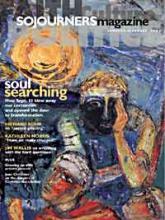Who would have thought that, 30 years later, John Lennons "Imagine" could be rescued from the dustbin of commercial sentimentality? Sure, it was wheeled out every Dec. 8 to commemorate the anniversary of Lennons death, but everyone knew the song was as dead as its singer. Now, in the post-Sept. 11 world, the song has again become a vital statement of hope and even a resource for resistance.
How did this happen? "Imagine" was not Lennons greatest solo hit; "Instant Karma" easily surpassed it on the charts. Even in 1971, the line "imagine no religion" was a hard sell in the pop marketplace. And on pop radio, that line about "no possessions" made for a bumpy segue into the car commercials. But back in 71, the song overcame those obstacles mostly on the basis of its ear-candy melody. It also came into an environment in which political protest was a fairly popular phenomenon. But there was more at work in the song even then. It was, and is, a stunningly direct and simple appeal to the human need for transcendence. In the midst of horrible war and domestic strife, the song asked the audience to listen to a tiny voice that suggested humans were made for peace and community.
When he was alive, Lennon said that "Imagine" was really "Power to the People" with a sugar coating. But that was only half right. The song was also the sequel to "All You Need is Love." In other early 70s songs, Lennon set to music the Freudian and Marxist interpretations of religion as a projection and an opiate. In "Imagine" it is placed alongside the nation-state as a tool of division and war-making. But in both "All You Need is Love" and "Imagine," you can also hear the sound of an unrelentingly honest man looking for a credible way to capitalize Truth.
Read the Full Article
